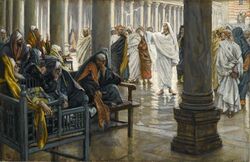Religion:Christianity and fringed garments
Christianity and fringed garments refers to the mention of fringed garments in Christian sources, and to the Christian appropriation of Jewish rituals, tzitzit and tallit.
New Testament
Matthew 9:20-22 says:
And a woman who had been suffering from a hemorrhage for twelve years, came up behind Him and touched the fringe of His (Jesus') cloak; for she was saying to herself, 'If I only touch His garment, I will get well.' But Jesus turning and seeing her said, 'Daughter, take courage; your faith has made you well.' At once the woman was made well.
Matthew 14:34-36 similarly says:
When they had crossed over, they came to land at Gennesaret. And when the men of that place recognized Him, they sent word into all that surrounding district and brought to Him all who were sick; and they implored Him that they might just touch the fringe of His cloak; and as many as touched it were cured.
Christian interpreters have connected these healings that the New Testament records taking place through Jesus' tzitzit with Malachi 4:2:
But for you who fear my name, the sun of righteousness shall rise with healing in its wings. You shall go out leaping like calves from the stall.
Christian interpreters have stated that this is a messianic prophecy fulfilled by Jesus because the Hebrew word "corners" (kanafim, כנפים), used in the Torah [1] for the place tzitzit are to be attached, literally means "wings". Therefore, interpreters say, the suffering woman and the others who were infirm found healing in Jesus' "wings".[2][3][4] Interpreters[who?] also say Jesus could be referred to by the name "sun of righteousness" because he is considered, in New Testament scripture, to be perfectly righteous and without sin.
Matthew 23:5 also has Jesus saying:
But they do all their deeds to be noticed by men; for they broaden their phylacteries and lengthen the tassels of their garments.
The common interpretation of this statement is that Jesus thereby explained that one should not do the commands of God in such a way as to be seen as more righteous and more zealous by others, similar to teachings found in the Discourse on ostentation. In this case, this motivation was evident in the Pharisees to whom he spoke.[5][6]
The Bauer lexicon, 3rd ed., 1979, includes this entry:
κράσπεδον: 1. edge, border, hem of a garment - But meaning 2 is also possible for these passages, depending on how strictly Jesus followed Mosaic law, and also upon the way in which κράσπεδον was understood by the authors and first readers of the gospels. 2. tassel (ציצת), which the Israelite was obligated to wear on the four corners of his outer garment, according to Num 15:38f; Dt 22:12. ... Of the Pharisees ... Mt 23:5.
Onkelos the proselyte, in his Aramaic translation of the Pentateuch, uses the same Greek loanword, krūspedīn (Greek: κράσπεδον) for the biblical word tzitzit in Numbers 15:38, and which, in Jewish custom, has the connotation of tassels.
In practice
While much of traditional Christianity has not considered Torah commands such as tzitzit applicable to Christians, there are Torah-submissive Christians who wear tzitzit. Like Karaites, Torah-submissive Christians generally do not feel bound by Jewish oral law, so tzitzit may vary in appearance and may contain blue which is not halakhically derived. However, because of practicality and convenience, traditionally Jewish tzitziot and tallits are often used.
Liturgical use
In Christian liturgy, the stole and other vestments worn by priests and bishops traditionally have fringes on the edge, in remembrance of the Old Testament prescriptions.
In the Eastern Orthodox Church, when the priest or bishop puts on his stole he reads a prayer taken from the Psalms of Degrees: "Blessed is God Who poureth out His grace upon His priests, like unto the precious ointment on the head, which runneth down upon the beard, even the beard of Aaron, which runneth down upon the fringe of his raiment." (Cf. Psalm 133).
See also
- Biblical law in Christianity
- New Testament
References
- ↑ Numbers 15:37-41
- ↑ "Archived copy". http://www.joelkurz.com/home/files/jesus_shema_authority_and_power.pdf.
- ↑ "Hope of Israel - Prayer Shawl and Bible Manners and Customs". http://www.hopeofisrael.net/index.php?option=com_content&task=view&id=63&Itemid=30.
- ↑ "The Hem of His Garment". http://www.rbooker.com/html/the_hem_of_his_garment.html.
- ↑ Commentary biblegateway.com [|permanent dead link|dead link}}]
- ↑ "U.S. Catholic Bishops - New American Bible". http://www.usccb.org/nab/bible/matthew/matthew23.htm#foot4.
External links
 |



